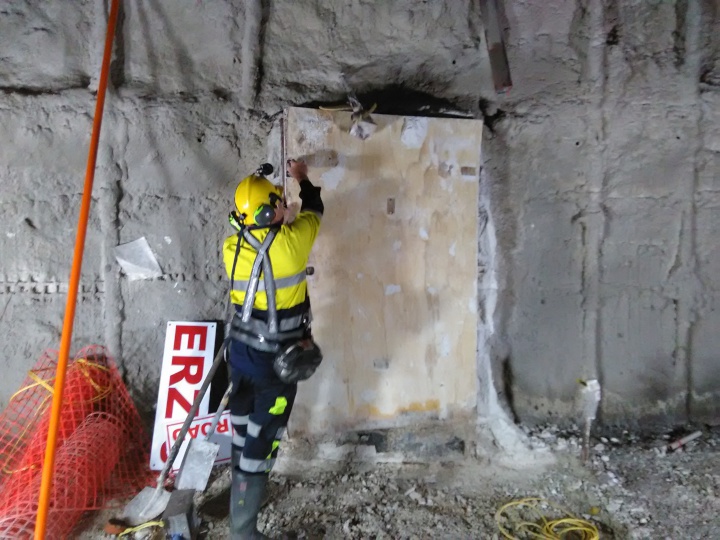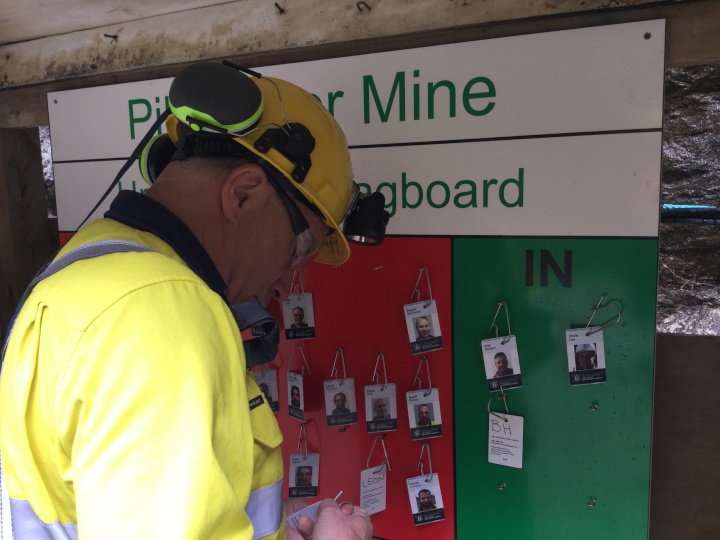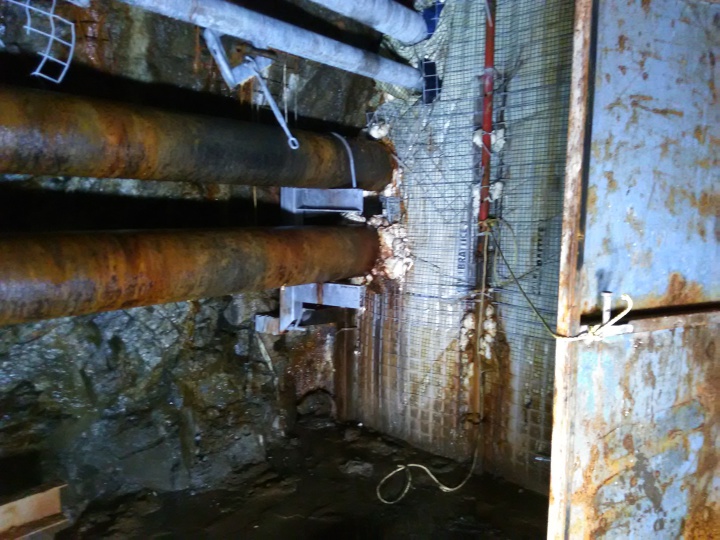Pike River team steps through 170m barrier
A team has stepped through the 170m barrier into the Pike River Mine drift today for the first time since the barrier was established by the New Zealand Mines Rescue Service in 2011.
“That was a long time coming,” Chief Operating Officer Dinghy Pattinson says of his journey with a small group of men with statutory roles.

Opening first door in the 170m barrier
“We’ve been going in and out of the drift up to the 170m barrier since 21 May. But last time I was on the other side of that 170, I was part of the Mines Rescue team looking for where to put a wall. And that was back in 2011. So today was pretty significant for me.”
The team’s initial scan did not reveal anything unexpected, he added.
“We know we’ll have to do some work on the roof and ribs as soon as we get the barrier out of the way in January. But it’s looking pretty good.”
Moving past the barrier marks the start of the next phase which will be to advance safely up the rest of the 2.3km drift, carrying out forensic examinations along the way, over coming months.

Looking towards the 170m barrier fro the mine drift
Two weeks ago the mining regulator WorkSafe agreed the Pike River Recovery Agency’s plans to re-enter and recover the 2.3km drift were safe.
“We’ve got a big job to undertake over coming months, and we wanted to get through if it was safe to do so before our Christmas closedown,” Dinghy said. “We’ll shut and secure the door now for a couple of weeks – it will give us more time to monitor the underground environment – before starting to remove the barrier in the new year.”
The team who went in checked for any hazards, inspected the state of the tunnel’s roof and walls, and had a brief forensic scan. Included were: Chief Operating Officer Dinghy Pattinson, Acting Underviewer Kirk Neilson, Mine Deputy Bryan Heslip, and Geotechnical Engineer Chris (Rick) Lee.<

At the tag board
How will you control the atmosphere in the mine drift when you remove the 170m barrier?
Our Final Gas Management and Ventilation Plan (2019) provides for a number of ventilation control devices (VCDs). The first, a Rocsil “plug” remotely inserted using boreholes close to the roof fall was completed in early November; with two other confirmed VCDs, (possibly more) – one inbye Pit Bottom in Stone - this seal will provide a stable atmosphere for an extensive investigation of the hundreds of metres of tunnel and mining infrastructure housed in the pit bottom in stone area; and the second just outbye the Rocsil plug.
I want to understand in detail how you’re planning to ventilate the mine with fresh air?
That information is available on the Agency website, search “ventilation” at www.pikeriverrecovery.govt.nz.

How long will all this take?
The project is event-driven rather than time-driven, and will be done safely. There are still significant unknowns.
What were the documents submitted to WorkSafe on Friday 13 September?
• Ventilation and Gas Management Plan
• Entry and Exit Execution Plan
• Pike River Mine Drift Re-entry Geotechnical Assessment
• Application for exemption from reg 170 (4) (a) of the Health and Safety at Work Mining Operations and Quarrying Operations Regulations 2016
• Force vs Exhaust Ventilation Risk Assessment
• Mine Entry and Exit Risk Assessment
• Emergency Management Principal Control Plan
• Single Entry Principal Hazard Management Plan
These documents are now available on our website.

Why did you need an exemption notice?
As previously announced, the plan includes an exemption for one aspect of mining regulations which has now been approved by WorkSafe under existing law. The Agency was required to demonstrate its plan was as safe or safer than the regulation.
Regulation 170 (4) (a) of the Mining Operations and Quarrying Regulations 2016 requires that there must always be an ability for workers to escape from a mine in an intake airway. The Agency sought an exemption to use a process called ‘forced ventilation’ in which fresh air is forced by a fan to the working space through a duct and then the air flows back (called return air) through the roadway to the entrance of the mine.
WorkSafe undertook a detailed review of the Agency’s exemption request and determined that worker health and safety outcomes were at least equivalent to the outcome of adhering to the regulation itself. WorkSafe was satisfied that the PRRA request met all legislative requirements for the granting of an exemption.



 Gordon Campbell: On Why We Can’t Survive Two More Years Of This
Gordon Campbell: On Why We Can’t Survive Two More Years Of This Peace Action Ōtautahi: Bridge Of Remembrance Peace Protest
Peace Action Ōtautahi: Bridge Of Remembrance Peace Protest National Wetland Trust: Public Asked To Help Prevent Fires In Wetlands This Summer
National Wetland Trust: Public Asked To Help Prevent Fires In Wetlands This Summer Lillian Hanly, RNZ: The Year In Politics - Stories That Dominated The Headlines In 2024
Lillian Hanly, RNZ: The Year In Politics - Stories That Dominated The Headlines In 2024 Waikato Regional Council: Studies Open Door To Mercury Islands Underwater World
Waikato Regional Council: Studies Open Door To Mercury Islands Underwater World Office of the Privacy Commissioner: Christmas Is About Giving, But Don’t Give Up Your Privacy
Office of the Privacy Commissioner: Christmas Is About Giving, But Don’t Give Up Your Privacy The Rail Advocacy Collective: Chris Trotter - Running Us Off The Rails
The Rail Advocacy Collective: Chris Trotter - Running Us Off The Rails


